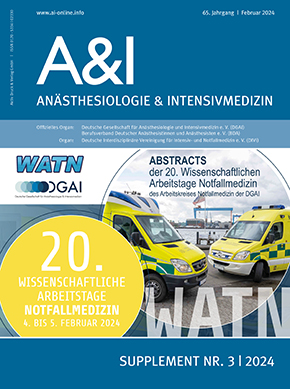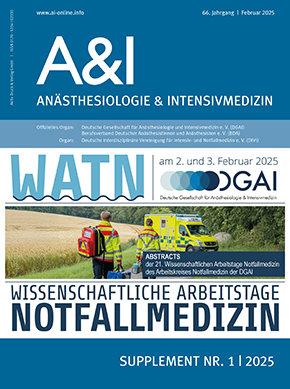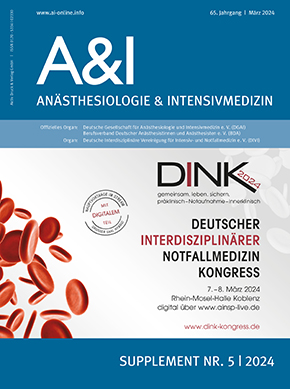

Aktuelle Ausgabe - 66. Jahrgang - Dezember 2025
Vergleich von Remifentanil und Sufentanil als Opioide der Allgemeinanästhesie in der ophthalmologischen Chirurgie
Comparison between remifentanil and sufentanil as opioids for general anaesthesia in ophthalmologic surgery
Hintergrund: Remifentanil wird als kurzwirksames Opioid vorrangig zur Analgesie bei kurzen operativen Eingriffen eingesetzt. Aufgrund eines Lieferengpasses wurde innerhalb eines achtmonatigen Zeitraums im Jahr 2017 in unserer Klinik für Operationen in der Ophthalmologie Sufentanil anstelle von Remifentanil verwendet. Ziel dieser retrospektiven Datenanalyse ist es zu untersuchen, inwiefern sich die Anwendung von Sufentanil zur Allgemeinanästhesie in der Ophthalmochirurgie im Hinblick auf den intra- und postoperativen anästhesiologischen Therapieverlauf von Remifentanil unterscheidet.
Methodik: Aus insgesamt 3.085 Patientendatensätzen konnten 620 Fälle anhand einer Matched-Pair-Analyse den zwei Studiengruppen zugeordnet werden (Remifentanil(R)-Gruppe und Sufentanil(S)-Gruppe). Die Datenerhebung und -auswertung erfolgten anhand der digitalisierten Narkoseprotokolle und mittels SPSS. Als Zielparameter wurden der intra- und postoperative anästhesiologische Behandlungsverlauf bis zur Verlegung aus dem Aufwachraum vergleichend ausgewertet.
Ergebnisse: Durch die paarweise Zuordnung konnten zwei vergleichbare Studiengruppen gebildet werden. Bei Allgemeinanästhesien mit Remifentanil wurde häufiger eine Gabe von Atropin (R-Gruppe: 12,6 %, S-Gruppe: 6,8 %, p = 0,014) oder Vasopressoren (R-Gruppe: 55,8 %, S-Gruppe: 32,3 %, p < 0,001) dokumentiert. Die Dauer der Allgemeinanästhesie sowie die Dauer bis zur Verlegungsfreigabe aus dem Aufwachraum waren zwischen den beiden Gruppen vergleichbar. Postoperatives Zittern konnte häufiger in der R-Gruppe beobachtet werden (R-Gruppe: 3,2 %, S-Gruppe 0,6 %, p = 0,020). Zum Zeitpunkt der Verlegung auf Normalstation waren mehr Patienten in der S-Gruppe schmerzfrei (R-Gruppe: 84,2 %, S-Grup-
pe 92,3 %, p = 0,002), wobei in der S-Gruppe intraoperativ häufiger ein Nichtopioid-Analgetikum verabreicht wurde als in der R-Gruppe (R-Gruppe: 10,6 %, S-Gruppe: 16,5 %, p = 0,035) und in der R-Gruppe postoperativ häufiger die Gabe von Piritramid erfolgte als in der S-Gruppe (R-Gruppe: 16,1 %, S-Gruppe: 9,7 %, p = 0,017).
Schlussfolgerungen: Sufentanil kann als Alternative zu Remifentanil bei kurzen und schmerzhaften Eingriffen in der Ophthalmochirurgie eingesetzt werden und scheint hierbei positive Effekte auf die intraoperative Hämodynamik und den postoperativen Verlauf zu besitzen.
Background: Remifentanil is a short-acting synthetic opioid that can be used as an anaesthetic for short surgical procedures. Due to a delivery shortage, we used sufentanil instead of remifentanil for surgical procedures in ophthalmology over a period of eight months in 2017. The aim of our retrospective data analysis was to assess how the use of sufentanil instead of remifentanil for general anaesthesia in ophthalmic surgery affected the intraoperative anaesthetic course and postoperative recovery.
Methods: After a preselection of 3,085 datasets, a total of 620 datasets were matched into two different groups (Remifentanil (R) group and Sufentanil (S) group). The collection and analysis of data was performed using the digitalised anaesthesia protocols and SPSS. Primary outcomes were the intraoperative and postoperative course of anaesthesiologic treatment.
Results: After pairwise matching, the two groups displayed no significant differences in patient characteristics. During general anaesthesia with remifentanil, the administration of atropine (R group: 12.6 %, S group: 6.8 %, p = 0.014) or vasopressors (R group: 55.8 %, S group: 32.3 %, p < 0.001) was more frequently required. The duration of general anaesthesia as well as the length of stay in the post-anaesthesia recovery area were comparable. Postoperative shivering was more common the R group. Postoperative shivering was observed more frequently in the R group than in the S group (R group: 3.2 %, S group: 0.6 %, p = 0.020). At the time of their discharge from the recovery room, more patients in the S group were pain-free (R group: 84.2 %, S group: 92.3 %, p = 0.002), whereas the intraoperative administration of a non-opioid analgesic drug was more frequent in the S group than in the R group (R group: 10.6 %, S group: 16.5 %, p = 0.035) and the postoperative administration of Piritramide was more frequent in the R group than in the S group (R group: 16.1 %, S group: 9.7 %, p = 0.017).
Conclusions: Sufentanil is a suitable alternative to remifentanil for short and painful ophthalmic operations and furthermore it also seems to have a positive effect on intraoperative haemodynamic stability and postoperative recovery.





















